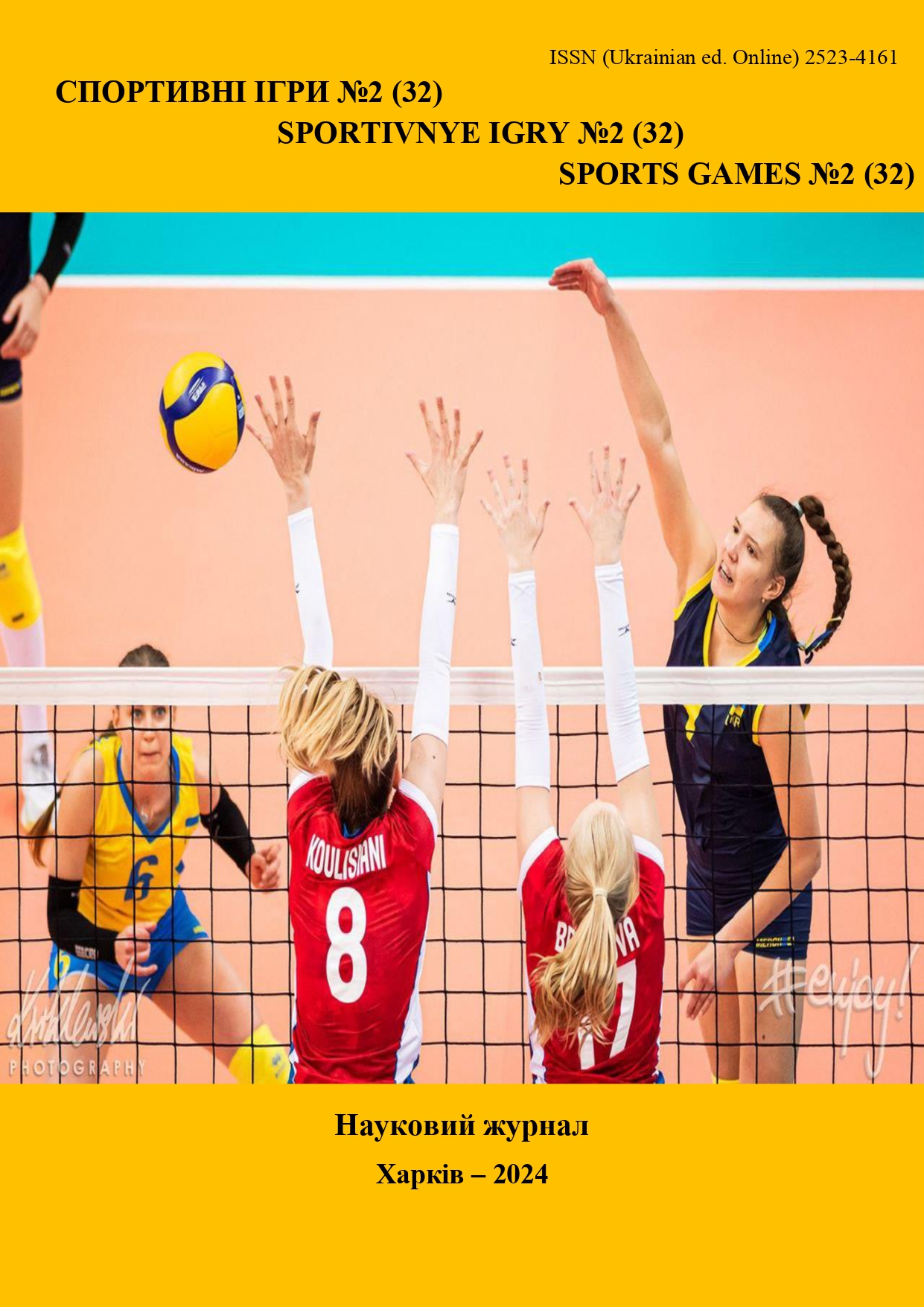Ефективність програми фізкультурно-оздоровчих занять із використанням народних ігор в процесі фізичного виховання дітей 3-4 років
DOI:
https://doi.org/10.15391/si.2024-2.07Ключові слова:
ігрова діяльність, діти дошкільного віку, психомоторний розвиток, ефективність, народні ігриАнотація
Одним із напрямів фізичного виховання та гармонійного розвитку дітей дошкільного віку є використання різних форм і засобів ігрової діяльності. Мета: визначити ефективність програми фізкультурно-оздоровчих занять із використанням народних ігор у фізичному вихованні дітей 3-4 років. Методи: аналіз, узагальнення та систематизація даних науково-методичної літератури; формувальний педагогічний експеримент, педагогічне спостереження, педагогічне тестування, психодіагностичні методи, методи математичної статистики. Організація: у дослідженні брали участь 57 дітей 3-4 років, серед яких 29 дівчаток та 28 хлопчиків. До експериментальної групи залучено 29 дітей, до контрольної – 28. До програми увійшли такі ігрові засоби: сюжетні (казкові) ігри з елементами драматизації; імітаційні ігри, що копіюють тваринний та природний світ; ігри з обмеженим мовленнєвим текстом; хороводні ігри і танки; ігри історичної та соціальної спрямованості; ігри з відображенням трудових процесів та побуту народу; обрядові та звичаєві ігри. Результати. У межах реалізації експерименту встановлено позитивну динаміку в розвитку психомоторних якостей дітей експериментальної (ЕГ) та контрольної (КГ) груп, проте вираження змін кількісних параметрів у розвитку психомоторики по завершенню експерименту відрізняється в дітей ЕГ та КГ, про що свідчать статистично кращі кількісні зміни досліджуваних показників дітей ЕГ. У результаті педагогічного впливу спостерігали поліпшення співвідношення кількості дітей за рівнем психомоторики. Наприкінці дослідження було виявлено з високим рівнем – 13,33 % дівчаток, вищим за середній – 26,67 % та середнім – 60,00 %, а хлопчиків − з високим рівнем – 14,28 %, вищим за середній – 28,58 % та середнім – 57,14 %, відповідно, за відсутності дітей з низьким рівнем розвитку психомоторних якостей. Також достовірно поліпшилися (p<0,05) показники психічного розвитку дітей ЕГ за усіма компонентами та досягнуто збільшення кількості дітей із позитивним емоційним станом (збільшення частки дівчаток з 66,66 до 86,67 % та з 57,14 до 85,72 % у хлопчиків). Загальний емоційний клімат в ЕГ наприкінці дослідження відповідав високому ступеню сприятливості.
Посилання
Андрєєва, О.В. & Чеверда, А.О. (2022). Використання фітнес-програми з елементами спортивних танців для розвитку координаційних здібностей дітей старшого дошкільного віку. Теорія і методика фізичного виховання і спорту, 1, 68-72.
Богініч, О.Л., & Бабачук, Ю.М. (2014). Рухливі ігри та ігрові вправи з елементами спортивних ігор для дітей старшого дошкільного віку: методичний посібник. Тернопіль: Мандрівець.
Вільчковський, Е.С. & Денисенко, Н.Ф. (2011). Організація рухового режиму дітей у дошкільних навчальних закладах: навчально-методичний посібник. Тернопіль : Мандрівець.
Вільчковський, Е.С. & Курок, О.І. (2019). Теорія і методика фізичного виховання дітей дошкільного віку: підручник. Суми: ПФ «Видавництво «Університетська книга».
Москаленко, Н., Полякова, А. & Ковров, Я. (2013). Сучасні підходи до організації фізкультурно-оздоровчої роботи у дошкільних закладах. Спортивний вісник Придніпров’я, 1, 40-42.
Пангелова, Н., Рубан, В. & Кусай, М. (2021). Рухова активність як чинник формування гармонійної особистості дошкільника. В: Науковий часопис НПУ імені М. П. Драгоманова. Серія 15, Науково-педагогічні проблеми фізичної культури (фізична культура і спорт), Вип. 5К(134)21, 97-106.
Пангелова, Н.Є. & Пивовар, А.А. (2018). Інтегрований розвиток інтелектуальних і фізичних здібностей дітей дошкільного віку в процесі рухової діяльності: монографія. Переяслав-Хмельницький.
Пасічник, В.М. & Талапа, І.І. (2020). Вплив фізкультурно-оздоровчих занять з елементами корфболу на фізичну підготовленість дітей старшого дошкільного віку. Спортивні ігри, 4(18), 60–71. DOI: 10.15391/si.2020-4.06.
Пасічник, В. (2020). Сутність ігрової діяльності у формуванні особистості дітей дошкільного віку. Спортивні ігри, 3(17), 43-57.
Пасічник, В. М. & Пасічник, В. Р. (2022). Перспективи удосконалення фізичного виховання дітей дошкільного віку засобами спортивних ігор. Спортивні ігри, 4(26), 28–39.
Andrieieva, O., Kashuba, V., Yarmak, O., Cheverda, A., Dobrodub, E. & Zakharina, A. (2021). Efficiency of children’s fitness training program with elements of sport dances in improving balance, strength and posture. Journal of Physical Education and Sрort, 21(382), 2872-2879. DOI:10.7752/jpes.2021.s5382
Krutsevich, T. & Pangelovа, N. (2013). Content and organization of physical education in the context of formation of integrated harmoniously developed child. Life and movement, 1(3), 3-7.
Lynch, M. (2015). More Play, Please. American Journal of play, 7, 347-70.
Panhelova, N., Krutsevych, T., Panhelova, M., Pyvovar, A., Ruban, V., Trotsenko, T., Kravchenko, T. & Bazylevych, N. (2020). Complex development of cognitive processes and physical abilities of children of preschool age in the process of motor activity. International journal of applied exercise physiology, 9(1), 73-88.
Pasichnyk, V., Pityn, M., Melnyk, V., Karatnyk, I., Hakman, A. & Galan Y. (2018). Prerequisites for the physical development of preschool children for the realization of the tasks of physical education. Physical Activity Review, 6, 117-26. DOI: 10.16926/ par.2018.06.16.
Wilczkowski, E. (2012). Wychowanil firyczne dzieci w wieku przedszkolnym. Piotrkow Trybunalski.













